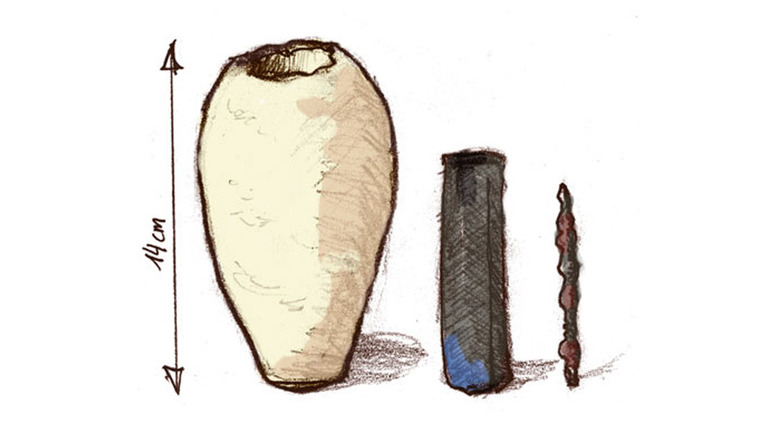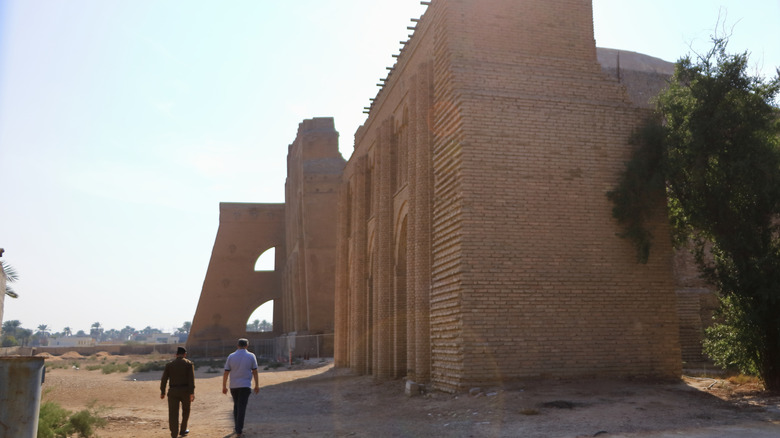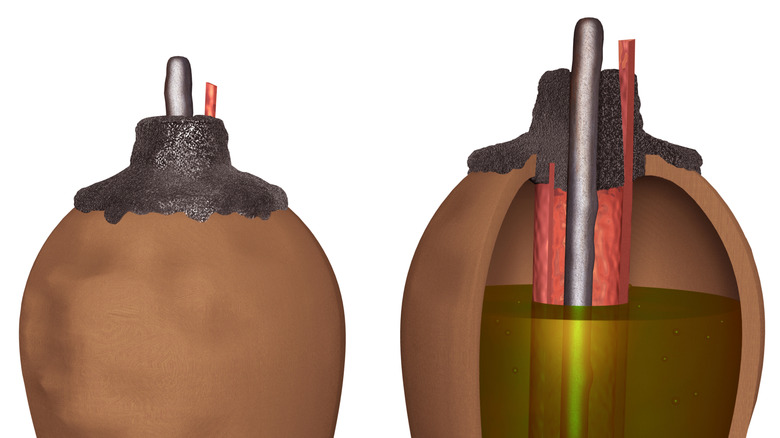Is The Baghdad Battery A Real Battery?
When is a battery not a battery? When it's a Baghdad battery. Some "weird history" authors and armchair archaeologists have claimed that a group of artifacts discovered in 1938 were ancient "batteries." The artifacts in question were four ceramic jars discovered by one Dr. Wilhelm König, an Austrian archaeologist — and painter — who found the artifacts, possibly in a grave located in the ancient and once royal city of Ctesiphon, about 20 miles from Baghdad. For archaeologists, finding ancient jars isn't rare. Claiming that they're early tech is — especially when compared to well-documented innovations from civilizations, like ancient Roman military technology. Such a claim needs to be backed by supporting evidence.
The find consisted of four five-inch ceramic jars. However, inside the jars, there were some unusual and still unexplained curiosities. We examine this in more detail below, but among the jars, three had cylindrical inserts of rolled copper sheets, and one had an iron rod inside the cylinder. Additionally, other iron rods were found with the jars. The cylinders were lead soldered to the bottom of the jars, and each one contained traces of papyrus. In short, they had all the makings of a rudimentary battery. However, before jumping to any conclusions, let's examine the science behind the claim and whether the Baghdad battery stands up to some reasoned arguments.
The history of the Baghdad battery
The history of Baghdad batteries is as murky as the claims of their purpose. First, let's address König's finding of the so-called batteries. There is no clear consensus as to whether they were excavated from graves or whether König simply found them in the basement of the Baghdad Museum, of which he was the director. Nor is there definitive agreement on the age and provenance of the artifacts. Originally, the jars were believed to date from the Parthian era, more specifically to about 200 BC. The Parthians were renowned warriors with no great history of scientific achievement. It's now more widely believed that the jars are of Sassanian origin — this is an era marking the boundary between the ancient world and a more scientific age. Which brings the date of the jars forward to between the years 225 to 640 AD.
However, with the onset of World War II, further exploration of the batteries was put on the back burner. When the war ended, the batteries surfaced again and new analysis of the artifacts found signs of corrosion by an acidic liquid. This prompted further investigation, and an American engineer named Willard Gray filled a replica jar with grape juice and managed to produce a charge of about 1.5 to 2 volts. An open and closed case it would seem, especially as other teams, including the TV show "Mythbusters," replicated the results. However, these and other subsequent tests only confirmed the possibility of electrochemical function — but not the intent behind the artifact.
König's artifact - a battery as charged?
Even with functionality, calling these batteries is a big claim, and big claims need strong evidence. Of which, there is none. There are theories of just what these "batteries" could have been used for, including electroplating, medicinal tools, or as ritual objects (but not as power sources for electric chariots). However, there has never been any evidence found to support these speculations. The electroplating theory can be dismissed because these simply wouldn't produce enough voltage, nor have wires been found suggesting that multiple jars were ever linked to generate electricity. The medicinal theory stems from the known fact that ancient Greeks used electric fish as a painkiller, but again, this can be ruled out because of the size of the current.
Additionally, the Sassanians were intellectually advanced, with the renowned Academy of Jundishapur, widely regarded as the world's first university. In such circumstances, it's highly unlikely that such a technology would simply be forgotten, or there would be some record of it and its uses. Finally, we need to consider the presence of papyrus in the jars. While it's unclear where exactly König found the artifacts, it's generally accepted that they originated from graves, and even König himself said that the jars could simply contain documents. In essence, they could just be a passport to the next realm. The truth is, we don't know what their real purpose is — but what we can say with some certainty is — it isn't a branded car battery.


